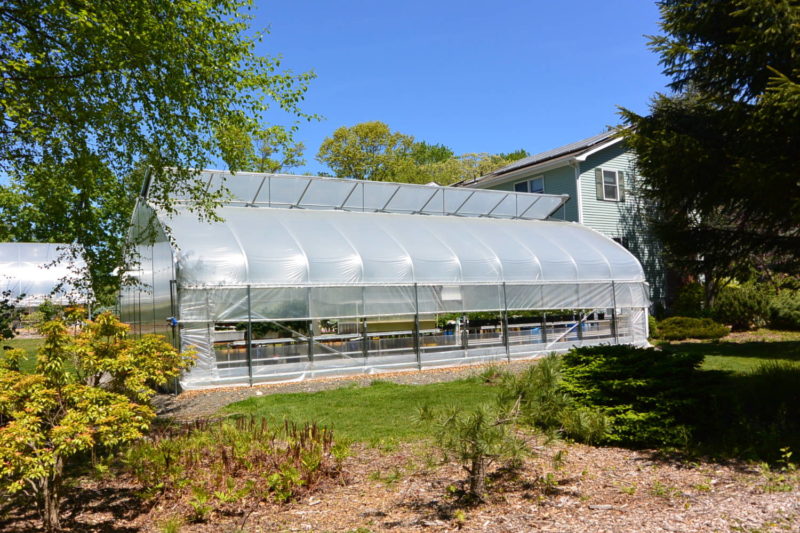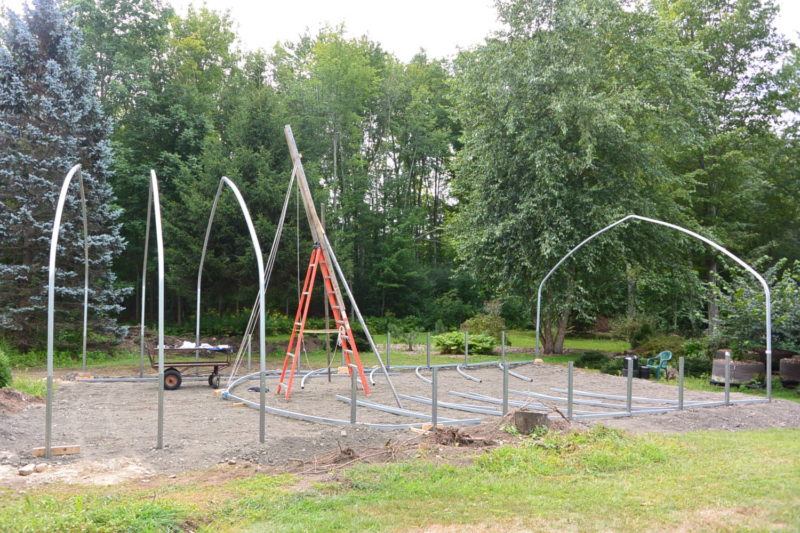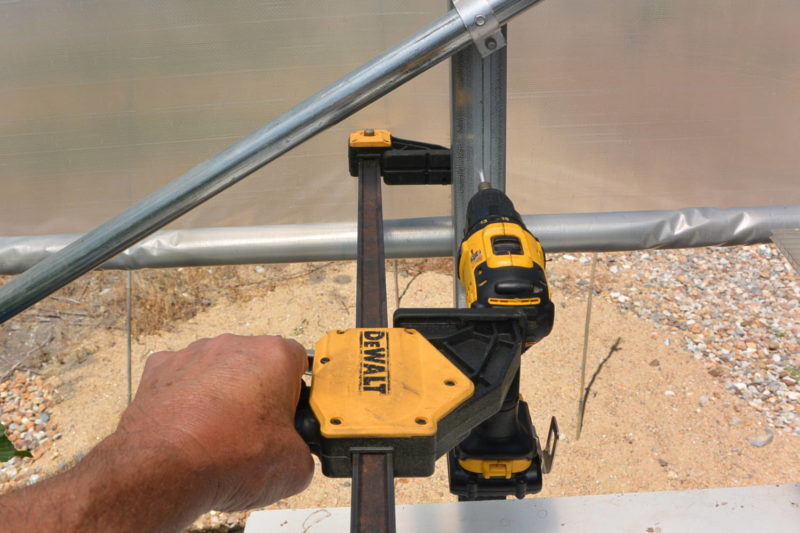Greenhouse Structures and Systems: Advancing Technology for Small Growers
Today’s guest is Keith Bemerer, inside sales rep for Rough Brothers, Inc., Cincinnati, Ohio. Keith earned his bachelor’s degree in agriculture specializing in floriculture crops at the Ohio State University in 2004. He spent two decades as a wholesale bedding plant grower prior to his current position and is the treasurer of the Cincinnati Flower Growers Association.
Peter: Welcome Keith, thanks for sharing your greenhouse expertise. As our backdrop today we can use my recent experience working with you to design a research greenhouse in my backyard as a case study. Specifically, let’s help growers with small-sized operations understand how high-level technology currently in use in large state-of-the-art ranges is filtering down to small footprint houses.
Keith: We have been seeing a major increase in the smaller houses such as yours for automation. I love the fact that you don’t have to spend an arm and a leg to use a full-panel computer system anymore and systems are getting smarter, smaller, and more autonomous in nature. The best part is that upgrading is not a painful undertaking and can easily integrate new components as your needs grow. One can generally go from a simple controller to weather control to computer control to smart device control and integrate all the way back to the controller.
Peter: My house is 24×40 feet, roughly 1,000 square feet. I didn’t want active ventilation, my exhaust fan/intake louvre days are done. I opted for a single roof vent and roll-up side vents on each side wall. The roof is inflated double poly,
end walls are twin wall polycarbonate, and roll-up side walls are a durable translucent material.
As you designed the structure I remember you saying a single roll-up side vent would be sufficient. Because the house is primarily for my research I wanted to avoid any possibility of a temperature gradient with the non-vented side being warmer due to less air flow than the vented side. Choosing the added cost of a second side vent, for me, was balanced against glazing the roof with polycarbonate, I concluded that I’d rather have more uniform temperature control in exchange for changing poly in five years.
Figure 1 shows the finished house with a feature not visible. The greenhouse is attached to my basement bulkhead by a 10-foot connector to allow access through the basement without stepping outside. During winter snow storms I’m able to go to the greenhouse to pick fresh veggies without taking my slippers off — it’s awesome.

Keith: We are seeing a lot of small houses with natural ventilation. Over 98% of the small structures will have a manual or automated roll-curtain system. Very rarely do growers want a dropcurtain style system or pad/fan or pad/ shutter combination unless they have special growing circumstances. In most cases, if the grower is looking for more air movement, we can add a 48-inch continuous automatic roof vent to pull air in through the sidewall and out the roof. There is one critical aspect when growing small, however — sidewall height. The taller the house the more air movement, and hence the cooler the crop being grown in natural ventilation.
Peter: The construction was more fun than I anticipated. Building 30×150-foot houses on my commercial range over many years had been normal for me and being tasked with a mere 24×40-foot project was seemingly a piece of cake … Not so fast. Building a greenhouse at the age of 65 compared to 35 made a big difference. This one was also to be built alone, which was a challenge that I enjoyed through the fall and winter. Manipulating 6×14 foot sheets of polycarbonate on the end walls last November remains memorable.
Another challenge to solve was erecting the individual bows alone. For that I built an extended hoist on a 10-foot step ladder. Figure 2 shows the hoist that raised each bow off the ground and into place via a double pulley system.
I put the energy/shade curtain on hold until funding is available, but you wrote one into my proposal, which was helpful in allowing me to see the big picture and prioritize upgrades. Are energy/shade curtains catching on for small growers?
Keith: Energy curtains are starting to get smarter, so yes, they are. Svensson introduced PARPerfect last year, which allows for the correct light level throughout a crop cycle. So, for poinsettias optimal light levels are maintained during propagation, potting, pinching and finishing, basically allowing the shade to be from 10 to 20% to blackout conditions in the same house. No more moving crops from house to house or worrying about light being too bright when sunny or too dim when cloudy.

Peter: Planning ahead for an energy curtain included opting for 6-foot-high side walls instead of the standard four foot. I was leaning toward the higher side wall anyway because I wanted plenty of head space above the benches along the walls for lights. Regardless of the energy curtain I’m very pleased we went with the 6-foot height as I’m able to use every bit of space up to the side wall comfortably. Even more important is your comment above that natural ventilation is more efficient in higher houses.
Keith: Shade systems are evolving and changing. With the smaller structures, many growers who do plan on shading the house still like to throw shade over the top of the house. The range of shade is 20 to 90%, with most growers choosing the 50 to 70% range. That said, we do have growers asking about internal flat retractable or slope/flat/slope systems that they can open or close with a timer, switch, or controlled automation. And while not that common, for CEA (controlled environment agriculture) we have requests for houses with light deprivation (blackout) systems.
Peter: Let’s finish off by discussing control system technology.
Keith: Bartlett instruments is moving to touch-screen control and is also moving more items to its “HeadGrower” application for smartphones, with an affordable monthly or yearly fee schedule. This allows seeing graphs down to the controller level without having to go to a computer to see data from the night before or 30 minutes before, helping the grower to make on-spot decisions standing in the greenhouse. The HeadGrower system can make changes as well to operate in a different mode while the grower is at home or on vacation.
Wadsworth is introducing a new Seed controller to fully integrate and combine into the fertigation and irrigation market (partnering with HE Anderson) so that you can choose recipes and chemigation programs from a computer to allow for even greater control.
Peter: Here’s another tip to share with fellow builders, one that others have likely thought of themselves. A second greenhouse in the background of Figure 1 is a 20×30-foot-high tunnel that I put up for a project two years ago. During construction my shoulders paid a price after driving hundreds of self tapping metal screws by wrapping one arm around the metal receiving the screw to create leverage pulling while pushing the cordless driver with the other arm. The tension on one shoulder and pressure on the other resulted in damage that lingers today.

I knew using this technique for the second greenhouse with hundreds more self tapping screws to drive wasn’t a smart choice. Portable drill presses are available for about $300 and I almost bought one. Then the idea hit me to try a woodworking bar clamp as a handheld drill press to relieve the pull-push on my shoulders (Figure 3). Once positioned squeezing the clamp handle with one hand and drill trigger with the other does all the work. It worked like a charm … and only cost $30. Buy the highest rated clamp; the one pictured is rated for 600 pounds of force, to withstand the repetitive task.


 Video Library
Video Library 




















